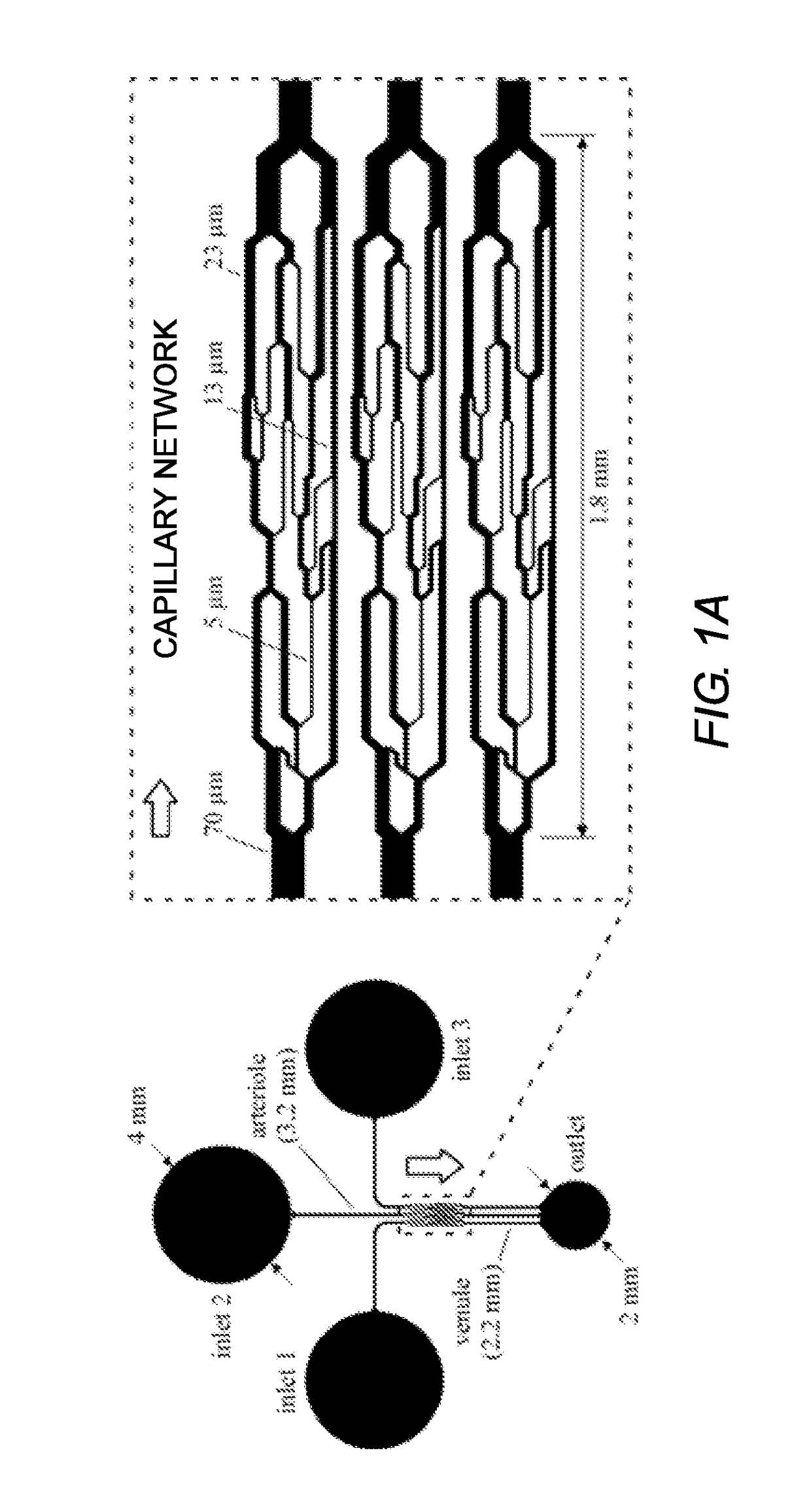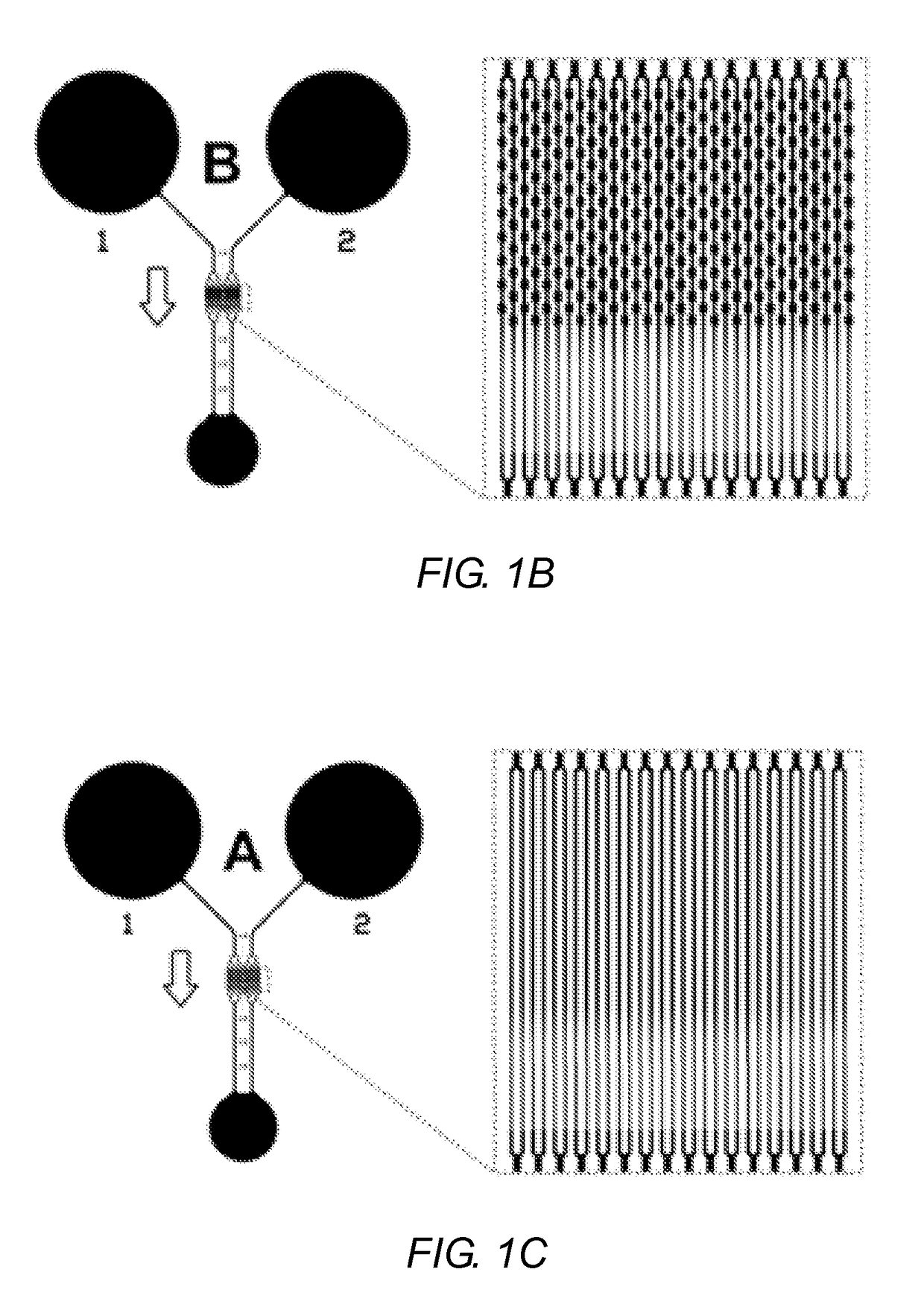Capillary network devices and methods of use
a network device and capillary technology, applied in fluid controllers, laboratory glassware, chemistry apparatus and processes, etc., can solve the problems of deteriorating rbcs, increasing acidity and hyper-osmolality, and hemolysis, and reducing the permeability of the capillary network
- Summary
- Abstract
- Description
- Claims
- Application Information
AI Technical Summary
Benefits of technology
Problems solved by technology
Method used
Image
Examples
example 1
Network Device Design
[0103]FIGS. 1A-1C show a schematic illustration of the three microfluidic devices according the present disclosure. FIG. 1A shows an aspect of a CND designed to mimic the morphological pattern of a mesenteric microvasculature. CNDs designed to mimic microvasculature may be referred to as an AMVN (Artificial Microvascular Network) device. FIG. 1B shows an alternative Capillary Network Device A (CND-A) having tapered microchannels as illustrated in FIG. 1D. The CND shown in FIG. 1C is another aspect of a Capillary Network Device (CND-B) having a series of repeating constrictions and expansions as illustrated in FIG. 1E.
example 1a
rtificial Microvascular Network (AMVN) Device
[0104]The AMVN device has three identical network units connected by 70 μm inlet microchannels and one common outlet port connected via 70 μm output microchannels. The channels are 5 μm deep. Each network consists of a 70 μm inlet microchannel that bifurcates two to three times to create one or more 5 μm interconnecting microchannels. The bifurcated channels then converge to microchannels of 13 μm and 23 μm before converging to the 70 μm output microchannel (FIG. 1A inset).
example 1b
Network Device A (CND-A) and B (CND-B)
[0105]CND-A illustrated in FIG. 1B and CND-B illustrated in FIG. 1C are designed to be identical except for the shape of their microchannel elements (the microchannels located in the center of the networks). Each device consists of two identical network units with two independent inlet ports and one common outlet port. Each network unit consists of a 70 μm inlet microchannel connecting the inlet port to a parallel array of 32 microchannel via a series of bifurcating junctions; each capillary array drains through a series of junctions to converge into a single 70 μm outlet microchannel. The microchannel arrays of FIGS. 1B and 1C are depicted in FIGS. 1D and 1E, respectively. In FIG. 1B, the tapered microchannels of CND-A comprise a 330 μm long, 5 μm wide straight portion followed by a 45 μm long portion gradually tapering to a 3 μm wide section that further extends to a length of 125 μm on the output side (FIG. 1D). In FIG. 1C, the microchannels ...
PUM
| Property | Measurement | Unit |
|---|---|---|
| cross-sectional width | aaaaa | aaaaa |
| length | aaaaa | aaaaa |
| width | aaaaa | aaaaa |
Abstract
Description
Claims
Application Information
 Login to View More
Login to View More - R&D
- Intellectual Property
- Life Sciences
- Materials
- Tech Scout
- Unparalleled Data Quality
- Higher Quality Content
- 60% Fewer Hallucinations
Browse by: Latest US Patents, China's latest patents, Technical Efficacy Thesaurus, Application Domain, Technology Topic, Popular Technical Reports.
© 2025 PatSnap. All rights reserved.Legal|Privacy policy|Modern Slavery Act Transparency Statement|Sitemap|About US| Contact US: help@patsnap.com



